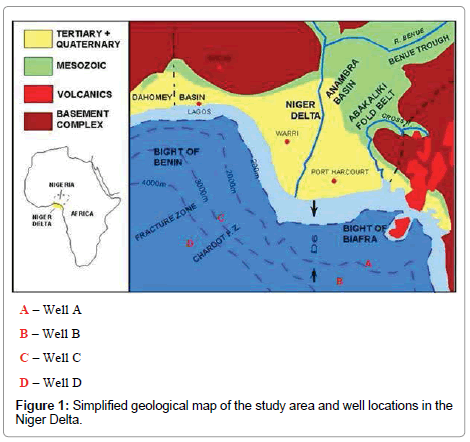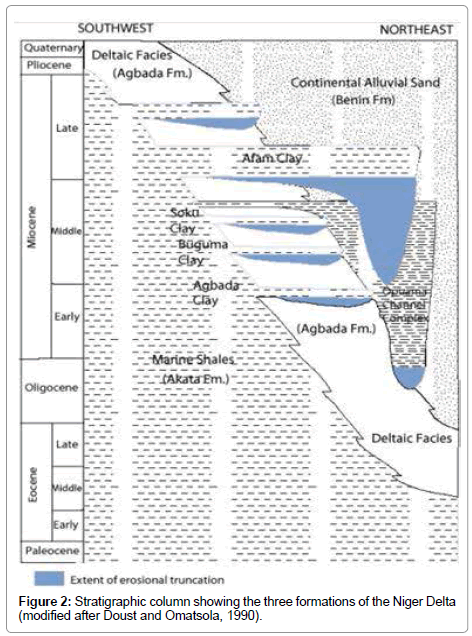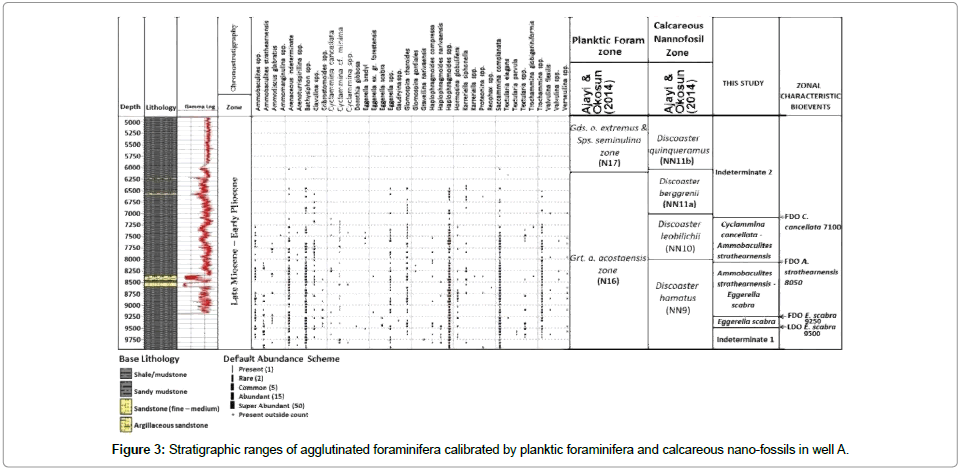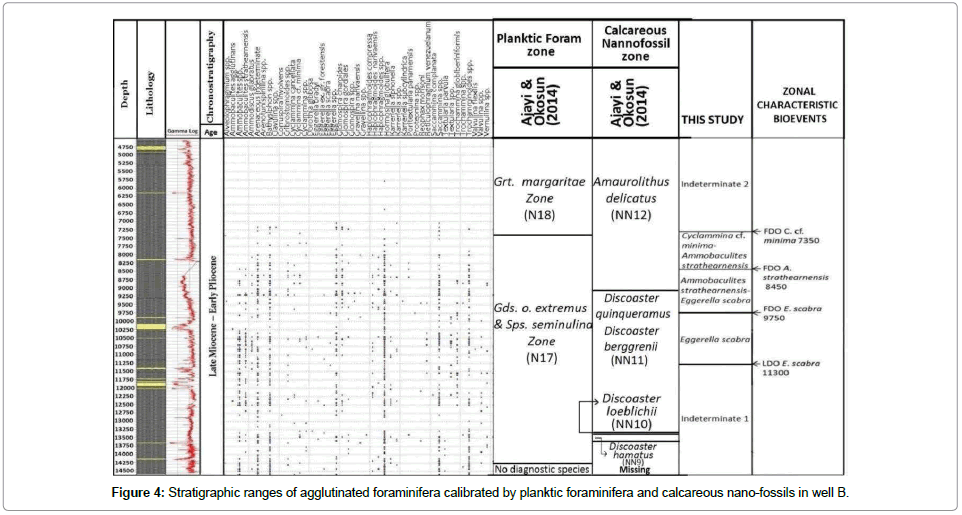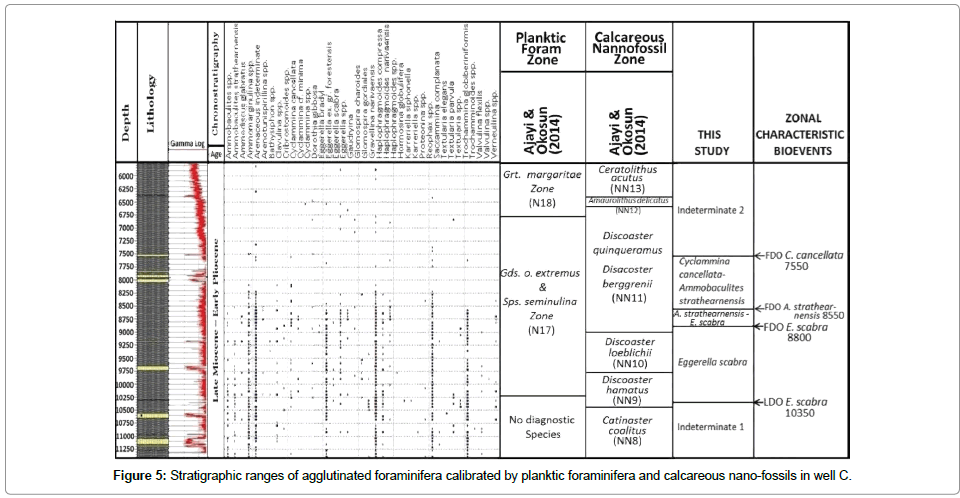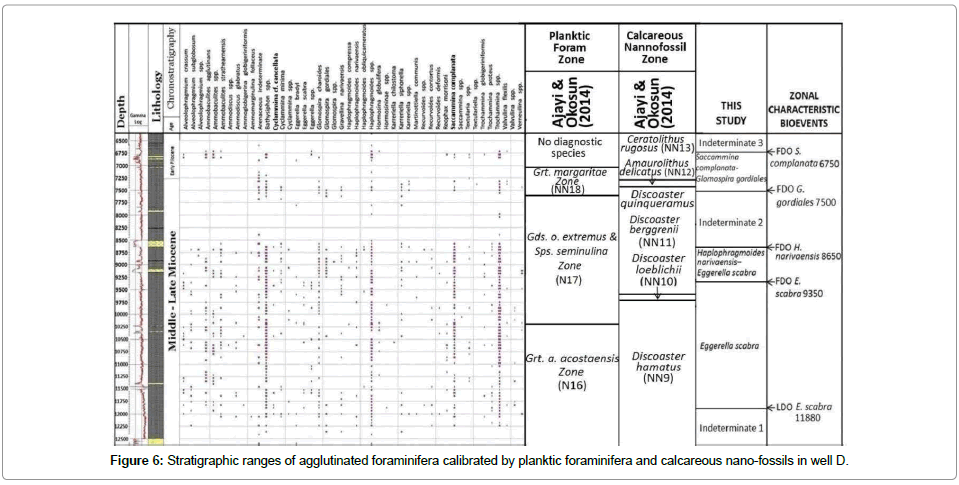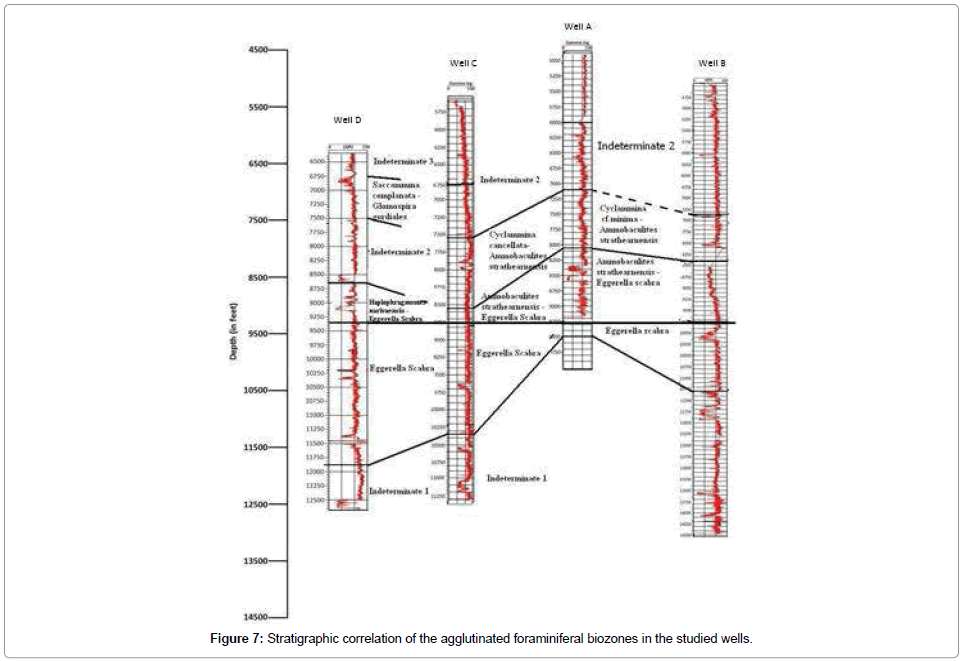Research Article Open Access
Neogene Deep Water Agglutinated Foraminiferal Biostratigraphy and Biozonation in Niger Delta, Nigeria
1Bio-Metrics Geo Consult Ltd, Cascurina Close Gaduwa Estate, Abuja, Nigeria
2Department of Geology Federal University of Technology, Minna, Nigeria
- *Corresponding Author:
- Ajayi EO
Bio-Metrics Geo Consult Ltd
Plot 68 Cascurina Close Gaduwa Estate
Abuja, Nigeria
Tel: 234 803 315 3422
E-mail: zusiajayi@yahoo.com
Received Date: October 31, 2016; Accepted Date: November 03, 2016; Published Date: November 10, 2016
Citation: Ajayi EO, Agboneni OE (2016) Neogene Deep Water Agglutinated Foraminiferal Biostratigraphy and Biozonation in Niger Delta, Nigeria. J Earth Sci Clim Change 7:371. doi: 10.4172/2157-7617.1000371
Copyright: © 2016 Ajayi EO, et al. This is an open-access article distributed under the terms of the Creative Commons Attribution License, which permits unrestricted use, distribution, and reproduction in any medium, provided the original author and source are credited.
Visit for more related articles at Journal of Earth Science & Climatic Change
Abstract
This study entails the biostratigraphy of benthic agglutinating foraminifera of four wells in the deep water of the Niger Delta. A total of 453 ditch cuttings were analysed for wells A, B, C and D. Eighty-five and 164 ditch cuttings from the intervals of 4900–9920 ft. and 4530–14600 ft. of wells A and well B respectively, while 92 and 112 cuttings from 5760–11400 ft. and 6000–12750 ft. were analysed in wells C and D respectively. These samples were processed and analysed at 60 feet intervals. . The analysed sections of the wells are composed of shale, mudstones and sand deposited in the upper to lower bathyal environments. The agglutinating foraminifera recovered were fairly well preserved. Total foraminifera percentages recovered from wells A, B, C and D wells are 31%, 34%, 24% and 27% respectively. Marker species were identified and used to erect biozones. The following six agglutinated foraminiferal zones beginning from the oldest have been proposed, Eggerella scrabra Taxon Range Zone, and Ammobaculites strathearnensis–Eggerella scabra, Haplophragmoides narivaensis - Eggerella scabra, Cyclammina cancellata–Ammobaculites strathearnensis, Cyclammina complanata–Glomospira gordiales, Cyclammina cf. minima–Ammobaculites strathearnensis Interval Range Zones. The agglutinated foraminifera assemblages were calibrated to the geologic timeframe by means of planktic foraminifera and calcareous nannofossils. The studied wells penetrated a sedimentary succession of Late Miocene to Early Pliocene age. Taxonomic notes on some of the observed species have also been provided.
Keywords
Neogene; Deep water; Agglutinated; Foraminiferal; Biostratigraphy
Introduction
Hydrocarbon exploration and production activities in the Niger delta which dates back to over five decades were mainly in the Eocene- Miocene onshore and shallow offshore sequences of the delta. But with the maturation of the onshore fields and availability of new technologies in the last decade, exploration and production of hydrocarbons have shifted to the deep offshore of the delta.
Biostratigraphy (foraminifera, calcareous nannofossils, pollen, spores and dinoflagellates) plays a significant role in the exploration and production of petroleum in the Niger delta. Many papers have been published on the foraminiferal biostratigraphy of the Niger delta [1- 17]. Biostratigraphic publications with primary focus on agglutinated foraminifera are not yet available from the Niger delta.
Deep water agglutinated foraminifera (DWAF) represent one of the most useful groups of microfossils for stratigraphical and paleoenvironmental interpretations of both high and low latitude areas [18-21]. They represent the most commonly recovered benthic organisms from strata deposited beneath the lysocline. DWAF find common applications for biostratigraphic work in the Deep Sea Drilling Project of the ocean basins and the Circum - Atlantic hydrocarbon basins [22,23] The main objectives of this work are to undertake the benthic agglutinated foraminiferal biostratigraphy and identify the biozones from four wells in the deep water of the Niger Delta of Nigeria (Figure 1).
Geological setting
The Tertiary Niger Delta is located in the Gulf of Guinea on the west coast of central Africa. It lies between latitude 4° and 6°, and longitude 3° and 9° E in the southern part of Nigeria. The Niger Delta covers an area of about 7500 km2 and is composed of an overall regressive clastic sequence which reaches a maximum thickness of 9,000 to 12,000 meters [24].
Three main formation names have been assigned to correspond to the tripartite subsurface sequence of the Niger delta (Figure 2). These are the Akata, Agbada and Benin Formations (Short and Stauble, 1967). The Akata Formation lies at the base of the deltaic sequence; the lithofacies is composed of shales, clays and silts with a few streaks of sand and sandstones possibly of turbidite origin. It is believed that the shale of this formation is the source rock for hydrocarbon in the basin and the shale outcrop offshore in diapers along the continental slope. This formation is overlain by the Agbada Formation which consists of alternations of sandstone and shale which forms the hydrocarbon prospective sequence of the Niger delta. The sandstones serve as hydrocarbon reservoirs and the shale contributing as source rocks and the seal. The Agbada Formation is underlain by The Benin Formation is composed predominantly of sand and sandstones with few shale intercalations. The overall sequence is strongly diachronous in the delta. The environment of deposition has been found to be of delta front, delta topset and fluvio detaic. Some parts of the delta experienced erosional truncation and resedimentation [25] The Agbada Formation was penetrated in the late Miocene to early Pliocene sequences of the four wells studied, piercing through the mobile shale, mud diapir and channelized turbidites.
Method of Study
A total of 453 ditch cuttings were analysed for the wells A, B, C and D. Eighty-five and 164 ditch cutting samples from interval of 4900–9920 ft. and 4530–14600 ft. of wells A and well B respectively, while 92 and 112 samples from interval of 5760–11400 ft. and 6000– 12750 ft. were analysed in wells C and D respectively. These samples were processed and analysed at 60 ft. interval for agglutinating benthic foraminifera using the standard micropaleontological sample preparation procedures.
Samples were first laid out sequentially according to their depths. Labels were prepared for each sample. Clean sample plates are laid out.
About 25 g of samples were placed (for ditch cutting samples) into the sample plates. The samples were dried on a hot plate at about 800°C for 2-3 hours. The sample plates were allowed to cool and weighed. Samples were soaked in kerosene and left overnight to disintegrate. The samples were decanted, topped with water and left overnight.
The samples were washed with liquid soap and water through four sieve mesh sizes of 500, 250, 150 and 63 microns and dried. Samples were transferred into four different bags/phials and labelled accordingly. Foraminifera were picked from the packaged samples and studied with the aid of a reflected light binocular Zeis microscope. All the agglutinating benthic foraminifera recovered were analysed. Generic and species identification were based on the proceedings of the past series of international workshops on agglutinated foraminifera and other relevant Neogene agglutinated foraminiferal publications.
Results and Discussion
Forty-six agglutinating benthic foraminiferal species were identified from the four wells in this study. The foraminiferal assemblages were fair to moderately well-preserved. Six benthic agglutinating foraminiferal biozones were recognized based on their stratigraphic distribution in the four studied wells (Figures 3-7).
Biostratigraphy
The identified agglutinating foraminiferal zones are beginning from the oldest: Eggerella scrabra Taxon Range Zone (TRZ), Ammobaculites strathearnensis–Eggerella scabra.
Interval Range Zone (IRZ), Haplophragmoides narivaensis – Eggerella scabra IRZ, Cyclammina cancellata – Ammobaculites strathearnensis IRZ, Cyclammina complanata – Glomospira gordiales IRZ, Cyclammina cf. minima – Ammobaculites strathearnensis IRZ.
The ages of the identified zones were calibrated to the geologic timeframe by means of planktic foraminifera and calcareous nannofossils from the studied wells [26]. First downhole occurrences (FDO) which represent the highest downhole occurrences of chronostratigraphically significant agglutinating foraminiferal species were used to define the upper and lower boundaries of the IRZ while FDO and the lowest downhole occurrence (LDO) of the nominate taxon defined the upper and lower boundaries of the TRZ. This zonal characterization is in accordance with the work of Murphy and Salvador.
Some intervals of the studied wells showed very poor agglutinating foraminiferal recovery or did not contain nominate or marker species. Such intervals were known as indeterminate zone (Figures 3-7). Details of the above biozones are presented below [27-36].
Eggerella scabra Taxon Range Zone (TRZ)
Stratigraphic range: This zone was identified in the four wells.
Well A: 9,250–9,500 ft.
Well B: 9,750–11,300 ft.
Well C: 8,800–10,350 ft.
Well D: 9,350–11,880 ft.
Definition: The zone is defined by the total taxon range of Eggerella scabra. The upper and lower boundaries are defined by the FDO and LDO of the nominate taxon respectively.
Characteristic taxa: Ammodiscus glabratus, Eggerella ex. gr. forestensis, Hormosina globulifera, Reophax morrisoni, Saccammina complanata, Glomospira charoides, Ammobaculites agglutinans, Alveolophragmium subglobosum and A. crassum.
Age: Late Miocene (NN9-NN11 and N16-N17) in the studied wells.
Ammobaculites strathearnensis–Eggerella scabra IRZ.
Stratigraphic range: The zone was identified in three of the studied wells
Well A: 8050–9250 ft.
Well B: 8450–9750 ft.
Well C: 8550–8800 ft.
Definition: The upper and lower boundaries of the zone are defined by the FDO of A. strathearnensis and E. scabra respectively.
Characteristic taxa: Trochammina globigeriniformis, Haplophragmoides compressa, H. narivaensis, Glomospira charoides, G. gordiales, FDO of Crybrostomoides spp, Ammobaculites glabratus, A. agglutinans, FDO of Trochamminoides spp and FDO of Saccammina spp.
Age: Late Miocene–Early Pliocene (NN9-NN12 and N16-N17) in the studied wells.
Cyclammina cancellata–Ammobaculites strathearnensis IRZ
Stratigraphic range: The zone was identified in two of the four wells.
Well A: 7100–8050 ft.
Well C: 7550–8550 ft.
Definition: The upper and lower boundaries of the zone are defined by the FDO of C. cancellata and Ammobaculites strathearnensis respectively.
Characteristic taxa: Saccammina complanata, Glomospira charoides, Haplophragmoides compressa, Ammobaculites glabratus, Cyclammina cf. minima, Ammobaculites spp, Trochammina spp, Textularia spp, Eggerella sp and Bathysiphon spp.
Age: Late Miocene (NN10-NN11 and N16-N17) in the studied wells.
Haplophragmoides narivaensis–Eggerella scabra IRZ
Stratigraphic range: The zone was identified in only one well.
Well D: 8650-9350 ft.
Definition: The upper and lower boundaries of the zone are defined by the FDO of H. narivaensis and FDO of E. scabra respectively.
Characteristic taxa: Karreriella siphonella, Glomospira gordiales, G. charoides, Gravellina narivaensis, Saccammina complanata, Trochammina proteus, T. globigeriniformis, Ammobaculites strathearnensis, FDO of Recurvoides contortus, FDO of Alvelophragmium subglobosum, A, crassum and Bathysiphon spp.
Age: Late Miocene (NN11 and N17) in the studied wells.
Saccammina complanata–Glomospira gordiales IRZ
Stratigraphic range: The zone was recognized in only one well.
Well D: 6750–7500 ft.
Definition: The upper and lower boundaries of the zone are defined by the FDO of S. complanata and G. gordiales respectively.
Characteristic taxa: Valvulina flexilis, Trochammina spp, FDO of Textularia spp, Glomospira charoides and Bathysiphon spp were recorded in the zone.
Age: Early Pliocene (NN12-NN13 and NN18) in Well D.
Cyclammina cf. minima–Ammobaculites strathearnensis IRZ
Stratigraphic range: The zone was identified in only one well.
Well B: 7350–8450 ft.
Definition: The upper and lower boundaries are defined by the FDO of A. strathearnensis and Cyclammina cf. minima respectively.
Characteristic taxa: Saccammina complanata, Glomospira charoides, G. gordiales, Cribrostomoides spp, Clavulina spp and the FDO of Trochammina spp.
Age: Early Pliocene (NN12 and N17) in Well B.
Systematics
Only the most frequent taxa of the deep water agglutinated foraminifera (DWAF) are referred to below. Some of them represent the zonal nominate taxa of the biozones from this study. The classification employed here follows that of Loeblich and Tappan (1963, 1987), initial reports of the Deep Sea Drilling Project and Ocean Drilling Programme, the various proceedings of the international workshops on agglutinated foraminifera since 1981 and other relevant journal papers.. No detail morphological descriptions are provided since they have been published in some of the above mentioned publications.
Sub-order : (Textulariina Delage and Herouard, 1896).
Super-family : (Haplophragmoidinae Maync, 1925).
Genus : (Haplophragmoides Cushman, 1910).
Haplogramiodes narivaensis, [Cushman and LeRoy, 1938 Plate I (Slides 6 and 7)]
Description: Test small planispiral and involute, composed of two volutions, the last of which is five to seven chambered. Umbilicus very deep and small, chambers tend to become elongate in axial direction and increase rapidly in size so that the end chamber is twice the size of the first chamber of the last volutions, aperture is interiomarginal, walls finely to coarsely arenaceous, surface smoothly finished.
Size: 0.20 mm – 0.27 mm
Remarks: Few well preserved individuals were recovered in all four wells.
Age : Late Miocene–Early Pliocene.
Genus: (Ammobaculites Cushman, 1910).
Ammobaculites strathearnensis, [(Cushman and LeRoy, 1938) Plate I (Slide 5)].
Description: Test free, elongate, ovate to round in section, compressed with seven rapidly enlarging chambers in the last whorl; the last chamber only slightly uncoiled, sutures are flush and zall coarsely agglutinated, aperture terminal.
Remarks: Common occurrence in wells A, B, C and D. Recovered specimens are well preserved.
Age: Late Miocene–Early Pliocene.
Family: (Textularidae Ehrenberg. 1838).
Subfamily: (Textulariinae Ehrenberg, 1838).
Genus: (Textularia Defrance in de Blainville, 1824).
Textularia pavula [(Carpenter, 1869)] Plate I (Slide 12)].
Description: Test free, elongate, biserial, generally more or less compressed in plane of biseriality or rarely oval to circular in cross section; chambers numerous, generally closely appressed, wall agglutinated, simple; aperture single low arch at base of last chamber.
Age: Late Miocene.
Family: Ataxophragmedae Schwager, 1877
Sub-family: Valvulininae Berthelin, 1826
Genus: Valvulina d’Orbigny, 1826
Valvulina flexilis [(Cushman and Renz, 1941) Plate I (Slide 4)].
Description: Moderately flaring triserial test with a strongly lobulate periphery, chambers expand fairly rapidly distorted pushed towards proloculus, thereby forming overlapping lobes, may be triangular in section, aperture wide and high on an excavated apertural face, wall fairly smooth, with angular quartz grains of uniform size set in an abundant matrix.
Remarks: Rare but well preserved individuals found in all four wells.
Age: Late Miocene.
Genus: (Karreriella Carpenter, 1869).
Karreriella siphonella [(Cushman, 1933) Plate I (Slide 3)].
Description: Three chambers in early whorls, later increasing in number or becoming uniserial aperture with valvular tooth, interiomarginal at least in early stage, may become terminal and modified to multiple aperture, test free, elongate, early chambers in trochoidspire of one or more whorls followed by well-developed biserial stage which may be slightly twisted about its axis, wall finely agglutinated, smoothly finished, aperture rounded, interminal face of final chambers, bordered by lip or produced on distinct slender neck.
Age: Late Miocene–Early Pliocene.
Super-family: (Ammodiscacea Reuss, 1862).
Family: (Ammodiscidae Reuss, 1862).
Sub-family: (Saccammininae Brady, 1884).
Family: (Saccamminidae Brady, 1884).
Genus: (Saccammina Carpenter, 1869).
Saccammina complanata [(Franke) Plate I (Slide 11)]
Description: Test free, single globular chamber, wall with pseudochitinous base, and outer agglutinated layer, firmly cemented, aperture rounded may be produced on short neck.
Age: Late Miocene
Family: (Ammodiscidae Reuss, 1862).
Sub-family: (Ammodiscinae Reus, 1862).
Genus: (Ammodiscus Reuss, 1862).
Ammodiscus glabratus [(Cushman and Jarvis, 1928) Plate I (Slide 15)].
Description: Test free, planispiral, or irregularly coiled. discoidal, proloculus followed by undivided planispirally enrolled tubular chamber which may show transverse growth, constrictions, but no internal partitions, wall agglutinated; aperture at open end of tubular chamber.
Age: Late Miocene- Early Miocene
Family: (Lituolidae de Blainville, 1827).
Sub family: (Cyclammininae Marie, 1941).
Genus: (Cyclammina Brady, 1879).
Cyclammina cancellata [(Brady, 1879) Plate I (Slide 14)]
Description: Planispirally coiled, involute coiling, round to somewhat lobate in outline, wall with reticulate, near surface meshwork beneath imperforate epidermal coating and commonly with labyrinthic interior; aperture single or multiple. The species has larger number of chambers (10 to 16) in the final whorl which distinguishes it from other members of the genus.
Age: Late Miocene - Early Pliocene
Cyclammina minima [(LeRoy, 1939) Plate I (Slide 13)]
Description: Test small, circular in transverse section, compressed, slightly umbilicate, periphery sharply rounded, chambers distinct, nine to ten in last whorl; sutures distinct, somewhat limbate, occasionally showing interior labyrinthic structure; aperture near base of last chamber on periphery, This species is recognized by the limbate character of the test and the distinct, limbate, radial sutures.
Age: Late Miocene- Early Pliocene.
Eggerella brady [(Cushman, 1933) Plate I (Slide 8)]
Description: Test free, conical or ovoid, triserial, with inflated and embracing chambers; wall agglutinated of calcareous particles with considerable cement, interior simple, aperture narrow, hook-shaped, interio-marginal and extending short distance up face.
Age: Late- Miocene.
Glomospira charoides [(Jones and Parker, 1860) Plate I (Slides 1 and 2)]
Description: Test free, consisting of spherical proloculus and undivided tubular, second chamber coiled in high spire around vertical axis nearly perpendicular to original axis; wall agglutinated; aperture at open end of tube.
Age: Late Miocene- Early Pliocene.
Correlation of Agglutinated Foraminiferal Biozones
The Eggerella scabra TRZ was found to be common to all the four wells while the Ammobaculites strathearnensis – Eggerella scabra IRZ was identified in three of the wells. Cyclammina cancellata - Ammobaculites strathearnensis IRZ has representation in two of the wells. The Saccammina complanata – Glomospira gordiales and Haplophragmoides narivaensis – Eggerella scabra IRZ have restrictions to well D while Cyclammina cf. minima – Ammobaculites strathearnensis IRZ was only identified in well B. The agglutinating foraminiferal biozones show good correlation in the four studied A, B, C, D wells (Figure 7).
Agglutinated benthic foraminifera
1. Glomospira charoides (Jones and Parker, 1860; Apertural view).
2. Glomospira charoides (Jones and Parker, 1860; Ventral view).
3. Karreriella siphonella (Cushman 1933; Side view).
4. Valvulina flexilis (Cushman and Renz, 1941; Dorsal view).
5. Ammobaculites strathearnensis (Cushman and LeRoy, 1938; Dorsal view).
6. Haplophragmoides narivaensis, (Cushman and LeRoy, 1938; Ventral view).
7. Haplophragmoides narivaensis, (Cushman and LeRoy, 1938; Dorsal view).
8. Eggerella bradyl (Cushman 1933; Ventral view).
9. Textularia spp. (Defrence In De Blainville, 1824; Dorsal view).
10. Pullenia bulloides (D’Orbigny, 1826; Dorsal view).
11. Saccammina complanata (Brady, 1884; Side view).
12. Textularia parvula, (Defrence In De Blainville, 1824; Dorsal view).
13. Cyclammina cf. minima (LeRoy, 1939; Dorsal view).
14. Cyclammina cancellata (LeRoy, 1939; Dorsal view).
15. Ammodiscus glabratus (Linne, 1758; Dorsal view).
Conclusion
The biostratigraphic analysis of the four wells A, B, C and D, showed the wells to be fairly rich and diverse in agglutinated benthic foraminifera. Six biozones comprising Eggerella scabra TRZ, Ammobaculites strathearnensis – Eggerella scabra, Cyclammina cancellata – Ammobaculitesstrathearnensis, Haplophragmoides narivaensis – Eggerella scabra, Cyclammina cf. minima–Ammobaculites strathearnensis and Saccammina complanata – Glomospira gordiales IRZ. The biozones were calibrated to the geologic timeframe by means of planktic foraminifera and calcareous nannofossils. The ages of the biozones range from the Late Miocene to the Early Pliocene. Three of the biozones have good stratigraphic correlation in the studied wells. The biozones could impact hydrocarbon exploration and production in the deep-water sector of the Niger Delta.
References
- Adeniran BV (1997) Quantitative neogene plankton foraminiferal biostratigraphy of western Niger Delta. Nigerian Association of Petroleum Explorationists Bulletin 12: 54-69.
- Ajayi EO, Okosun EA (2014a) Calcareous nannofossil biostratigraphy of A. B. C. D Wells, Offshore Niger Delta. Nigeria. Earth Science Research3: 108-123.
- Ajayi EO, Okosun EA (2014b) Plankticforaminiferalbiosratigraphyof A, B, C, D Wells, Offshore Niger Delta. American International Journal of Contemporary Research 4: 108-120.
- Chukwu JN, Okosun EA, Alkali YB (2012) Foraminiferal biostratigraphy and depositional environment of Oloibiri-1 well, Eastern Niger Delta, Nigeria. Journal of Geography and Geology 4:114-122.
- Docker K, Rogl F(1988)Earlycretaceous agglutinated foraminifera from limestone-marl rhythmites of the GrestenKlippen belt. Eastern alps 41: 41-51.
- Doust H, Omatsola E(1990) Niger Delta In: Edwards JD and Santogrossi PA (eds) Divergent/passive margin basins. American Association of Petroleum Geologists Memoir 48: 201-239.
- Fadiya SL, Jaiyeola-Ganiyu FA, Fajemila OT (2014) Foraminifera biostratigraphy and paleoenvironment of sediments from well AM- 2, Niger Delta. Ife Journal of Science 16:61-72.
- Fajemila OT (2012) Foraminifera biostratigraphy and paleoenvironmental studies of two wells from offshore Western Niger Delta. Ife Journal of Science 14: 369-384.
- Gradstein FM, Berggren WA(1981) Flysch-type agglutinated foraminifera and the Maastritchtian to Paleogene history of the Labrador and North Sea. Marine Micropaleontology 6: 211-268.
- Green RC, Kamiski MA, Sikora PJ(2004) Miocene deep water agglutinated foraminifera from Viosca Knoll, offshore Louisiana (Gulf of Mexico). Proceedings of the sixth International Workshop on agglutinated Foraminifera. GrzybowskiFundation Special Publication 8: 119-144.
- Haack RC, Sundararaman P, Diedjomahor J, Xiao H, Gant NJ, et al. (2000) Niger Delta Petroleum Systems, Nigeria.
- American Association of Petroleum Geologist Memoir (2001) Petroleum Systems of South Atlantic Margins.73: 213-231.
- Hospers J (1971) The geology of the Niger delta area. The geology of Eastern Atlantic Continental Margin. Great Britain Institute of Geological Science Report 70: 121-142.
- Kaminski MA, Gradstein FM, Scott DB, Mackinnon KD (1989) Neogene benthic foraminiferal stratigraphy and deep water history of sites 645, 646 and 647, Baffin Bay and Labrador Sea. Proceedings of the Ocean Drilling Program, Scientific Results 105: 705-730.
- Kaminski MA, Silye L, Kender S(2009) Miocene deep-water agglutinated foraminifera from the Lomonosov Ridge and the opening of the Farm Strait. Micropaleontology 55: 117-135.
- Loeblich AR, Tappan H(1964) Treatise on invertebrate paleontology, part C: Protista 2, Sarcodina chiefly: Thecamoebians and Foraminiferida. Univ Kansas Press for GeolSocAmer Lawrence 1,2: 900.
- Loeblich AR, Tappan H(1987)Foraminiferalgenera and their classification. Van NostrandRienhold Company, New York, USA.
- Murphy MA, Salvador A(1994) International stratigraphic guide - an abridged version International Subcommission on Stratigraphic Classification of IUGS. International Commission on Stratigraphy, Special Episodes.
- Nagy J, Kamiski MA, Kuhnt W, Bremer MA(2000) Agglutinated foraminifera from neritic to bathyal facies in the Paleogene of Spitsbergen and Berents sea. Proceedings of the Fifth International Workshop on Agglutinated Foraminifera, Grzybowski Foundation Special Publication 7: 333-361.
- Nagy J, Kaminski MA, Gradstein FM, Johnston K (2004) Quantitative foraminiferal and palynomorph biostratigraphy of the Paleogene in southwestern Brent Sea. Proceedings of the Sixth International Workshop on Agglutinated Foraminifera. Grzybowski Foundation Special Publication 8: 359- 379.
- Obaje SO, Okosun EA(2013a)Benthicforaminiferalbiozonation and correlation of XY-1 Field, Offshore Western Niger Delta, Nigeria. International Journal of Science and Technology2: 536-542
- Obaje SO, Okosun EA (2013b) Taxonomic notes on marker planktonic foraminifera of Tomboy Field, Offshore Western Niger Delta, Nigeria. International Journal of Science and Technology2: 622-627.
- Obaje SO, Okosun EA(2013c)Plankticforaminiferalbiozonation and correlation of XY-1 Field, Western Niger Delta, Nigeria. International Journal of Science and Technology3: 160-166.
- Obaje SO, Okosun EA(2013) Taxonomic notes on marker benthic foraminifera of Tomboy Field, offshore western Niger Delta. International Journal of Science and Technology3: 357-364.
- Ojo A (1996) Studies on biozonztion and paleoecology Neogene foraminifera of central Niger delta. Unpublished PhD thesis, ObafemiAwolowo University, Ile-Ife, Nigeria.
- Okosun EA, Liebau A (1999) Foraminiferal biostratigraphy of Eastern Niger Delta, Nigeria. Nigerian Association of Petroleum Explorationist Bulletin14:136 -156.
- Okosun EA, Chukwu JN, Ajayi EO, Olatunji AO(2012) Biostratigraphy, depositional environment and sequence stratigraphy of Akata field (2, 4, 6 and 7 wells), Eastern Niger Delta, Nigeria. International Journal of Scientific and Engineering Research 3: 1-27.
- Okosun EA, Chukwuma-Orji JN(2016) Calcareous benthic foraminiferal biostratigraphy and paleoenvironment of deposition of KK-1 Well, Offshore Western Niger Delta Nigeria. Journal of Basic and Applied Research International 17: 202-210.
- Okosun EA, Chukwuma-Orji JN (2016)Plankticforaminiferal biostratigraphy and bio-chronology of KK-1 Well, western Niger Delta, Nigeria. Journal of Basic and Applied Research International 17: 218-2016.
- Ozumba MB(1995)LateMiocene-pliocenebiostratigraphyoffshoreNigerDelta.Nigerian Association of Petroleum Explorationists Bulletin 10: 40 - 48.
- Ozumba MB, Amajor LC(1999) Evolutionary relationships in some benthic foraminifera of the middle to late Miocene, Niger Delta. Nigeria Association of Petroleum Explorationist Bulletin.14:157-16.
- Petters SW (1982) Central West African Cretaceous -Tertiary benthic foraminifera and stratigraphy. Paleontographical Acta 179: 1-104.
- Petters SW (1983) Gulf of guinea planktonic foraminiferal biochronology and geological history of the South Atlantic. Journal of Foraminiferal Research 13: 32-59.
- Petters SW (1995)Foraminferalbiofacies in the Nigerian rift and continental margin Delta. In: Oti MN, Postma G. (eds.) Geology of Deltas, AA. Balkema, Rotter-Dam 267.
- Salami MB(1982)Bathyal benthonic foraminiferabiofacies from the Nigerian sectorof the Gulf of Guinea (West Africa). Revista Espanola de Micropaleontologia 14: 55-461.
- Short KC, Stauble AJ (1967) Outline of the geology of Niger Delta. American Association of Petroleum Geologists Bulletin 51: 761-779.
Relevant Topics
- Atmosphere
- Atmospheric Chemistry
- Atmospheric inversions
- Biosphere
- Chemical Oceanography
- Climate Modeling
- Crystallography
- Disaster Science
- Earth Science
- Ecology
- Environmental Degradation
- Gemology
- Geochemistry
- Geochronology
- Geomicrobiology
- Geomorphology
- Geosciences
- Geostatistics
- Glaciology
- Microplastic Pollution
- Mineralogy
- Soil Erosion and Land Degradation
Recommended Journals
Article Tools
Article Usage
- Total views: 11643
- [From(publication date):
October-2016 - Apr 03, 2025] - Breakdown by view type
- HTML page views : 10698
- PDF downloads : 945

